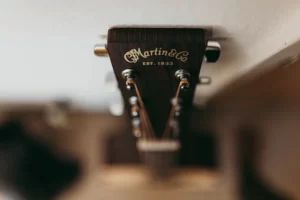So many individuals don’t know the procedure to change the guitar strings. Guitarists may believe that they know how to string a guitar, but they have probably not mastered the correct method. “I’ll just thread the strings all around the tuning apparatus, and it’ll work,” they’ll say.
If only this were that simple… If you want to have pleasure while playing an instrument, you must first prepare yourself for accomplishment. Otherwise, you’ll be out of tune all the time, breaking strings, and generally not having fun…
We don’t want it to happen. We are trying to show everyone how to string a guitar like one pro today. That’s a way that ensures your strings won’t go in and out of harmony as often and won’t cause any unnecessary damage.
Why Should You Replace Your Guitar Strings?
Acoustic strings, to most stuff in life, deteriorate with age. When you notice dust, corrosion, or “funk” on your strings, it is time to replace them. You can notice grit on the thread when you observe your guitar string, particularly at the first fret.
Restring your guitar after one month as a general guideline. Consider replacing your strings every two weeks when you often perform and for longer durations.
If you are specifically looking to change the nylon strings, please look at our article on how to string a classical guitar.
What Is Required to String a Guitar?
- Guitar
- Strings in a pack
- String trimmer
- Winder of strings
- a smooth surface
- What is your favorite record/album? (for listening, of course)
- A relaxing liquid (be it water, whiskey, coffee, or tea)
However, picking the correct set of strings is another story you can learn about in this. We’d recommend a luminous string that isn’t too expensive for understanding – anyway if you damage a string when getting it on!
Step 1: Untangle the Strings
Begin with the energy Intensity string (the thinnest string). To reduce the string’s pressure, utilize your string blower.
- If you’re not sure which direction to adjust the tuner, pull the note and twist.
- If the note becomes higher in pitch, you’re moving in the wrong direction!
Working your way down from a high E string to the low E string, shorten each string until they’re all loose and lying on the fretboard.
Step 2: Remove the Strings
If you have any bottled-up rage, now is the moment to let it all out. Cut each string immediately above the soundhole with your string cutters.
- Pull the string well above the soundhole to avoid scratching your guitar’s finish!
- Cut the cords one by one time to enjoy the moment. You shouldn’t get to break guitar strings every day!
Step 3: Cut the Strings
You’ll most certainly need bridging hooks that keep the strings in position while discovering how to string an electric guitar. Bridge pegs are the small pegs on your instrument’s bridge. Loosen the bridge’s pins using your string winder.
- The majority of string tuners have a slot that allows you to handle the bridge pins without damaging the guitar easily.
Pull straight up once you’ve secured the bridge pin in the string winder’s notch. Do not take an angle with the bridge pins! The bridge pins will most certainly shatter as a result of this. When you pull the puck off the strings out from bridges, keep in mind you replace the bridge pin inside its hole so there are no missing bridge pins. The next step is removing the string from the soundboard (where the tuning machines are).
Warning: the string tips are scratchy. Ensure you don’t hurt yourselves by mistake!
- Coiling the strings over one another is a safe technique to control them, so they don’t hurt you or have an unfortunate accident!
Optional Step: Make the Guitar Shiny
After removing all of the strings from the instrument, you may clean any hard-to-reach areas. Now you’ll not need to be doing this. However, we always run a clean cloth around the fretboard, neck, and at the bridge as a good practice. These areas tend to gather dust, so it’s always good to clear them while you have the opportunity!
Let’s all get back to practicing how to restring a guitar after you’ve cleansed those stains!
Step 4: Put the New Strings Together
Each string module has a unique naming scheme to distinguish which string is in which to learn about that standard, read the package. If the strings cannot be identified, simply look at the stats on the wrapping: the increase the number, the wider the string. Whether you’re searching for string choices, keep in mind that it is the least expensive with the sound of your guitar.
String packs might be dirt inexpensive or outrageously costly. However, strings are nearly always less expensive than an entire guitar. Open the box away from the edge after finding the low E string.
If you’re not careful, the string may uncoil and stab you in the back.… That is not what we desire. Untwist the strings and arrange them on the workstation.
Step 5: String Your Guitar!
Hold the ball-end of your low E string against the bridge pin to generate a slight bending in the strings.
- This allows the ball end to rest on the bridge plate within the guitar – a complete pro move! Then, insert the spherical end of the string into the slot in which the low E string should be.
Lastly, tighten the string by inserting the bridge pin into the hole.
- That might be a little gooey, so don’t be afraid to apply some pressure.
- If pressing the bridge pin requires too much power, remove it and try it again.
Repeat this method for each string. The guitar may appear like the one at the conclusion of this step.
Step 6: Thread & secure the strings
You’ve accomplished half of the tonal change when fresh strings are strung on a guitar. This next section, the remaining 50%, sparks unending disagreement among guitarists.
- How should the strings be threaded and wound on the tuner’s posts? We will teach you a popular method that practically everyone can use.
Begin by lubricating the nut slots with a pencil (I like a carpenter’s pencil since this graphite is lovely and soft). Adding graphite helps the strings to flow easily through a nut and prevents tuning troubles when you string your guitars. You will require 20 minutes.
How to String a Guitar at Tuners
Use The Tuning Post to tune the low E String
Insert the string’s pointed end through to the hole in the bottom of the optimization post.
Tighten The String, Then Add Slack
Push the tailed end of the wire together halfway through to the adjusting peg hole. Check that the string is in the proper nut slot. After that, the string is taut. Generate slack here on pitching the post with your palm towards the fretboard.
Begin Winding The String
Make sure the initial rotation of the tuning post travels well over the slack end of the rope as you tighten. This will guarantee that the string is securely fastened.
Make Adjustments As You String The Guitar
It is critical that the initial wrapping of the string all-around pitching post passes well over the empty end of a string; nevertheless, the first wrap should not drop off the top.
Make Sure That The String Unwinding Direction Is Correct
Make sure the string is wrapping it towards the middle of the neck as you twist the pitching peg.
Continue String Wrapping
Following the initial wind, each subsequent wind will move beneath the tail end of the wire towards the neck.
Tail Ends Should Be Clipped
Don’t forget to use your string cutters to trim the tail ends. Cut the tail end as near the tuner post as possible to avoid snagging on anything!
The Strings Should Be Stretched And Tuned
After changing the strings of a guitar, you must extend and tune the strings. Place your finger on the twelfth fret and gently bend the string. This will stretch the thread and allow it to adapt.
Conclusion
Congratulations! Now you have learned how to string a guitar like a professional! It is critical to update your strings on a regular basis. If you don’t, your tone will decrease, and you will have less pleasure playing your guitar.







